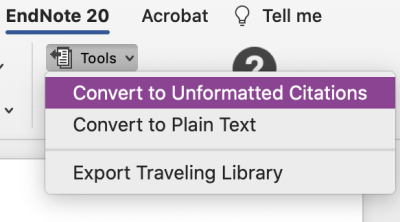Technology has evolved and cloud-based software has become the norm. However, this has created some unique issues when it comes to scholarly publishing. Most authors today use citation management tools to assist them in collecting, organizing, and citing references in their manuscripts. While some more recent citation management tools were built in the cloud, such as RefWorks, Zotero, and Mendeley; others started as desktop software programs.
These desktop-based products, most notably EndNote, have struggled to adapt to the changing technologies. In 1989 EndNote Version 1 was released as a ”Reference Database and Bibliography Maker” for Apple Macintosh by Niles & Associates (EndNote was first acquired by Thomson Reuters in 2000, and in 2016 it fell under their spin-off company Clarivate Analytics [now called Clarivate]).
By 1992 EndNote had several competitors, including ProCite and Reference Manager (both later acquired by Thomson Reuters and subsequently discontinued). By the time EndNote 4.0 was released in 2000, most of EndNote’s core functionality was in place. In 2020, EndNote 20 was released, and the most recent update is EndNote 20.2.
EndNote Web
In 2007, EndNote released EndNote Web, a web-based version of EndNote that was integrated in ISI Web of Knowledge (today known as Web of Science). EndNote Web later became EndNote Basic (there are two versions) and EndNote Online.
- EndNote Basic is a web-based reference manager that allows for up to a maximum of 50,000 references and 2GB of attachments. There are two different versions of EndNote Basic.
- A free web-based only version of EndNote with limited functionality (21 citation styles and a limited number of filters and connection files). It requires no additional purchases, subscriptions, or licenses.
- An upgraded version of EndNote Basic that is available to individuals who have institutional subscriptions to Web of Science. This version of EndNote Basic has thousands of citation styles and hundreds of filters and connection files.
- EndNote Online is the cloud-based portion of the licensed EndNote Desktop. This online version of the desktop library can contain an unlimited number of references and attachments.
- EndNote Online can only sync to ONE (1) EndNote Desktop Library, and from there users can share references and collaborate with others.
- EndNote Online syncs with EndNote desktop versions: X8, X9 and 20.
Microsoft Moves to the Cloud
Microsoft 365 (formerly Office 365) is Microsoft’s subscription-based suite of products, including the core Microsoft Office software (Outlook, Word, Excel, PowerPoint, etc), as well as many additional cloud-based business services such as Microsoft Teams, SharePoint, and OneDrive.
Many of the core office products in the 365 suite also include the current desktop versions of the office applications – currently Microsoft Office 2021. Office 2021 is also sold as a one-time purchase of the Office applications for a single computer. There is also an Office for the Web, which is a free version of the core Office applications that can be used right in the browser.
Read more here: What’s the difference between Microsoft 365 and Office 2021?
NOTE: MSK has an site license for Microsoft 365, and all MSK employees are able to access Microsoft Office software both on their desktop workstations as well as in the cloud via SharePoint.
So what does all of this mean for EndNote?
One of the most challenging aspects of this changing landscape is that these two companies (Microsoft and Clarivate, the owner of EndNote) fail to be able to fully cooperate in making their products work seamlessly.
The biggest hurdle is for users who want to collaborate with their colleagues to write manuscripts. Below are just a few of the overlapping issues currently playing out.
- EndNote Desktop does not allow for sharing of libraries/groups or collaborating with colleagues; it must be done by syncing through EndNote Online. Only one (1) desktop library can be synced to EndNote Online. Shared groups appear in EndNote 20 desktop simply as links back to EndNote Online.
- Office 2021 (desktop version of Word) can only connect to either EndNote Desktop or EndNote Online, but not both at the same time using the Cite While You Write (CWYW) plugin.
- Microsoft 365’s Word (cloud-based in SharePoint) is not compatible with EndNote CWYW at all, therefore documents must be opened in the Word desktop application to make edits in the document.
- Documents formatted with EndNote cannot safely be stored in cloud-based storage.
- Co-editing Word documents that are formatted with EndNote CWYW that are living outside of a shared folder or drive (e.g. SharePoint, GoogleDocs, DropBox) can corrupt the document.
What’s the Solution?
- Create ONE (1) single library within your EndNote Desktop
- .enl + .data (library + data folder, on either Windows or Macs)
- .enpl (packaged library, only available on Macs)
- Use Groups and Group Sets to organize references
- Sync your single EndNote library to EndNote Online
- Create shared groups either in EndNote Desktop or EndNote Online and sync.
- Invite collaborators to the shared group from within EndNote Online.
- Use the desktop application of Microsoft Word to add and edit EndNote citations to the Word document.
 Store Word documents in cloud-based storage like SharePoint, OneDrive, and DropBox as “unformatted” citations.
Store Word documents in cloud-based storage like SharePoint, OneDrive, and DropBox as “unformatted” citations.
- This allows for multiple people to edit the document without corruption and without the need to constantly email versions back and forth.
- Do not use Track Changes in Word with EndNote, it must be turned off (not visible) in order to format documents properly without errors.
For further assistance with citation management, check out our scheduled Library Classes, or take a look at our self-guided resources on our Citation Management LibGuide.